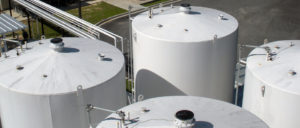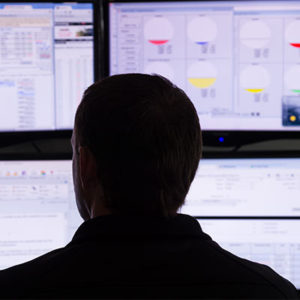Wireless tank level monitoring
Wireless tank level monitoring: Three key advantages
Properly monitoring and managing levels inside storage tanks can help owners and asset managers improve efficiencies and increase productivity and profitability.
In this article, Fritz Cleveland shares three key advantages to wireless monitoring.
Fritz Cleveland, Banner Engineering, 10/10/2017
Storage tanks, totes, and containers can be found in a wide variety of locations and  environments, from indoor or outdoor installations to above or below ground deployments. Their numbers are vast and contents can vary greatly across applications. Properly monitoring and managing levels inside these receptacles can help owners and asset managers improve efficiencies and increase productivity and profitability.
environments, from indoor or outdoor installations to above or below ground deployments. Their numbers are vast and contents can vary greatly across applications. Properly monitoring and managing levels inside these receptacles can help owners and asset managers improve efficiencies and increase productivity and profitability.
The combination of wireless connectivity with wirelessly-enabled ultrasonic sensors is proving to be an effective and increasingly popular method for tank level monitoring. These solutions can overcome many common challenges related to container location, contents, and quantity to provide users with access to timely, accurate tank level information with significant benefits for resource allocation and cost reduction.
Simple solutions, problematic results
There are a number of methods and tools that can be used to measure levels inside a container. Simple solutions, such as visual inspections and measuring sticks, are very easy to implement and require little or no investment in equipment. However, these methods can be imprecise, easily susceptible to error, and labor intensive. The number of tanks requiring inspection, the distance to the tanks, and the level of difficulty—even risk—in accessing the tanks and their contents are all significant challenges that add time and expense to the process. Add to those expenses any wear and tear on vehicles, travel expenses, and lost productivity of staff, as well as the opportunity for injury or accident in gathering the data.
Manual inspection methods also rely upon manual reporting methods. Data from each tank is collected and recorded by staff at the site. This data typically is logged into a spreadsheet or entered into a management system when the staff member returns to the office or can easily access a network-connected PC or other devices. In many cases, the information from the tanks is already out-of-date by the time data has been logged.
Accurate measurements
More accurate tools for measuring content levels, such as magnetostrictive floats and submersible pressure transducers allow managers to make more informed decisions about their business. These devices are not dependent upon human labor to measure levels, which can simplify processes, minimize the risk of error, and eliminate many of the safety concerns associated with acquiring the data. However, these tools determine levels by making contact with the contents of the container. This may not be acceptable in applications where contact with measurement tools or other equipment can contaminate the contents. Additionally, prolonged contact may degrade the performance, accuracy, and longevity of these tools.
Ultrasonic sensors are cost-effective and easy-to-implement solutions that are particularly well-suited for use in these applications. These sensors use sound waves to detect objects, so they do not need to come into contact with the materials they are measuring. Because they do not rely upon light energy for detection, they largely are unaffected by conditions that typically challenge photoelectric sensors. They are immune to target color, reflectivity, or transparency, are unaffected by light conditions, and perform well in wet environments. Ultrasonic sensors capable of a proportional analog output enable greater measurement accuracy and are a preferred choice for these applications. The data provided by these sensors easily can be converted into liters, gallons, meters, or feet.
Collecting with a wired solution
These more accurate measurement tools typically support advanced methods of data collection. By integrating these tools into a network connected to the internet, asset managers are able to access current tank level data from a convenient location. Data is easily accessible and as accurate as the most recent measurement. Network connectivity essentially eliminates the need to deploy staff to a site to measure, record, and log tank level data.
While wired infrastructure is capable of connecting asset managers with their stored assets, the challenges associated with implementing, expanding, or altering wired networks in these applications can be prohibitive.
- Purchasing the hundreds, or even thousands of meters of twisted pair wiring, including all the conduit and accessories required to connect each device in a deployment as well as building in capacity to accommodate any future expansion to the network can be very expensive.
- Running the wire to all the containers in the network is a time-consuming and labor-intensive process that can be further complicated by the time and expense of tearing out and replacing concrete, asphalt, or other obstacles in order to trench the wire.
- Altering wired networks incurs new expenses and requires time and labor to implement. If for any reason tanks ever need to be moved, the wires connecting the containers to the network also will need to be moved and if the new tanks need to be added to the network beyond the capacity initially designed into the system, new wires will need to be run.
- In many instances, integrating tank level measurement equipment into a wired network is not cost-effective, practical, or even possible.
Advantages of wireless remote monitoring
1. A cost-effective solution that saves time and money.
Comparatively, connecting measurement tools in a wireless network is far more cost-effective than wired networks. By eliminating the need for wires, companies eliminate the expenses and hassles associated with installing, altering, or expanding wired infrastructure. These include hardware and labor costs as well as lost time and productivity. Additionally, whereas a wired system can require substantial changes to infrastructure, the changes required in a wireless system are minimal.
Wireless systems also are far easier to implement than wired systems. In a basic setup, a wireless node is connected to a measuring device, like an ultrasonic sensor, and installed on the container. Each node in the network is bound to a wireless gateway or controller with an integrated gateway.
Next, a site survey is conducted to verify the connection between the deployed nodes and the gateway. The system is then configured, and inspection parameters and alarm thresholds are set. Lastly, an Ethernet or cellular connection is established, enabling remote access to the data collected from the tanks. A system like this can monitor many containers and can be setup in a fraction of the time and at a fraction of the cost of a wired network.
2. Real-time data and alerts for quick troubleshooting and data-driven decisions.
By connecting the network to the Internet, asset managers have easy access to timely, accurate information. This provides significant benefits for efficiency and productivity. Rather than  sending staff to a site based on forecasted expectations of container levels or an arbitrary schedule, managers can strategically plan visits, as well as routes and resources, based on actual need. This makes it easy to keep tanks filled and processes running without overstocking a site.
sending staff to a site based on forecasted expectations of container levels or an arbitrary schedule, managers can strategically plan visits, as well as routes and resources, based on actual need. This makes it easy to keep tanks filled and processes running without overstocking a site.
In collection applications, this information can be used to prevent overfills and to ensure that staff and equipment are not sent to a site to empty, move, or remove under filled containers. For companies providing either of these services, this can translate into added capacity from staff and equipment to better serve existing customers and add new customers to client rolls. Additionally, accurate data collected over time, can be used to create more precise forecasts to direct business and support decisions.
Remote monitoring can minimize the potential for problem situations to arise. However, sudden changes in use, equipment failure, and other unexpected events can cause dramatic changes in content levels. A dry tank can have negative consequences for equipment dependent upon the contents of a container and processes may be brought to an unexpected halt. An overfill situation can be wasteful, damage equipment, and may have environmental consequences. A wireless system easily can be setup to alert key personnel via text or email if tank levels are outside of the established parameters. Workers can respond to a problem situation before it has the potential to become critical.
3. Versatility to expand to changing business needs.
Business needs can change over time and companies may need to add or move containers at a site to keep up with new demands. Wireless networks are versatile, highly-scalable, and can easily be adapted to meet changing needs. Containers can be moved as much or as little as needed without altering the system or disconnecting the node and measuring device; containers can be monitored even while in transit. New nodes and sensors taking measurements from new containers can be integrated into a network or an entirely new network can be deployed to accommodate a new group of tanks, all with relative ease and without incurring substantial costs or requiring large commitments of time and labor.
Implementing a tank monitoring system that utilizes ultrasonic sensors in a wireless network has many advantages. Wireless systems can be setup quickly, cost-effectively, and without large commitments of human labor or changes to infrastructure. They are capable of monitoring many containers and can adapt to meet changing needs and scale to accommodate new containers. Automated alerts can be setup to notify staff of potential issues, minimizing the opportunities for emergency situations to develop. The data generated by these systems is more accurate and can be accessed from anywhere and at any time. This allows managers to make more informed decisions about their assets, how they are used, when they should be serviced, and what staff and resources are needed to service them.